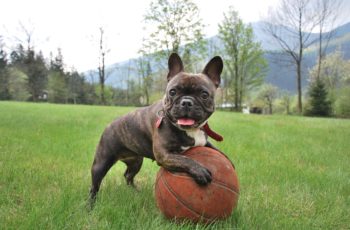When training any new behavior, it is essential to determine whether or not a reward is required. Yes, there are times when it is not necessary to reward a behavior. By doing so, you run the risk of undermining the value of that particular reward.
It is crucial to have a reward the dog wants, whether it’s food, toys, or affection. You are teaching your dog to come back so that he or she can get a reward. You must prove to your dog that coming back is beneficial.
Note: If you are using food treats, they should be small and eaten quickly. Otherwise, your dog will not associate coming back with getting a reward.
11 Steps for your Dog to Come on Command
Step #1 – Start the process by saying, “Come!”
The basic command for learning this is “come,” but before you start working on that sound, it is essential to first establish the command. When you are teaching your dog to come, stick close to them and focus on their body language. If they are stiff or tense, you can tell them to “sit.” If they are wagging their tail, suggest that they say “Here” or “Heel. Once you have established the basic command, begin to work with “Come!”
Step #2 – Begin to use “Come” as the default command
Continue repeating the basic command, and your dog will continue to ignore you. If your dog does not ignore you, likely, your dog cannot come because external factors (such as a leash or another dog) prevent your dog from coming to you.
Tip: Repeat this process until your dog comes.
Step #3 – Progress from “Come” to “Go”
Use your imagination and ask your dog to perform super basic behaviors. Ask your dog to sit, stay, down, and come whenever you ask them to. “Sit,” “Stay,” and “Down” are all names for the same behavior, so you can say it once when you are training and use the term that makes more sense in your mind. Imagine and then practice “Go” over and over again.
Tip: If your dog is not responding to your commands, label him or her with a reminder word. This will help you see that he or she understands what you want! If your dog labels objects in the room (bed, couch, etc.), use the word “Bed.”
Step #4 – Progress from “Come” to “Go” to “Heel!”
Trainers would give them two commands: “come here” and “heel. ” When the dog would get within a certain distance., they would say “heel,” thus getting the dog to follow them in a straight line.
Giving them one command: “come here.” In this instance, the dog was trained to go to its owner with a wagging tail and full excitement.
However, the trainers also wanted their dogs to heel with their back straight and to walk in a straight line next to them. These dogs had to be told to “heel,” instead of “come here.” The difference was that the dog would still approach the trainer while wagging its tail, but it took away all of the energy from the dog. The dog would now follow its handler in a straighter line but without all of the excitement. This allows for more control over the dog.
Step #5 – Teach your dog to come from a distance
Now that your dog is coming when called, it is time to teach your dog to come from a distance. If you have a fenced-in yard, that’s the best place for this exercise. If not, go to an area where there are no distractions. Start off by using the 15-foot line and work your way up to 150 feet.
Tip: Be sure that you use this line correctly without moving it at all. Here are the directions: The line is marked from left to right, and each time you call your dog to come, your dog gets 5 feet closer to you. The last time you call your dog to come, they get right up next to you. If your dog is getting too large for this space, increase the number of steps per exercise.
Step #6 – Use treats as rewards
That last step was a huge one. Dogs are not like humans, where they can see a treat in their mind. That is why we use treats as rewards for our dogs. For this command, it is easiest to start off with a clicker. A clicker is a small handheld device that you can buy at most pet stores. Use it to indicate when your dog performs correctly. It makes the process more fun for both of you and ensures that your reward is given at the right moment (just after a job well done). To use it, push the button and then immediately give your dog a treat when he or she responds appropriately. You can also use the click as praise to tell your dog what a good boy he or she is.
Step #7 – Teach your dog to come from a distance with no treats
Once you have your dog coming from a distance with a clicker, you can up the ante and start using no treats yet. This gives your dog more responsibility for what they are doing so that they are less likely to cheat and come when you aren’t looking.
Step #8 – Teach your dog to come to you from a distance with no treats
Once your dog responds appropriately from a distance, it is time to move on to working at a closer distance. You should notice that it becomes easier for them to come closer and closer. This is because they have already learned that they get a reward when they do what’s asked. So, continue using treats, but you will be walking toward them instead of sitting still in your chair for this exercise.
At this point, you should have your dog performing at least one step closer to you, and when you give your clicker in response, they will happily sit at your feet. Once they are sitting, make sure that they get a treat right away and begin working on their recall.
Step #9 – Teach your dog to come to you from a distance with treats
Now that your dog is moving towards you on command, it’s time to build on that because you want to be closer. You will still be using the clicker and treats to reward your dog when moving towards you on command. The only thing that will change is that you will be walking backward, a little bit farther away from your dog each time.
So, first, take your dog out into the yard so they can get their experience with coming to you from a distance. Then, use the same approach to begin moving towards you each time you mark with your clicker. You will then give your dog a treat while they are walking backward. When you remove the leash, you will increase the distance between you and your dog. Again, this is something that needs to be constantly reinforced. It would help if you also tried walking towards them in this situation and reinforcing the behavior even more.
When dogs are taught to come on command, there is no getting into a car or going for a walk without doing it. Of course, your dog can learn how to listen to different commands and to respond accordingly when they hear them.
Step 10 – Use a leash to ensure your dog will come.
Now, it’s time to use the leash, and may this be the end of your problems with obedience. This, too, can be taught using treats or a clicker. The principle is identical:
- Take the lead.
- Go back and forth in front of them.
- Treat them when they perform in the desired manner.
The first step is to put the lead on your dog and let him or her drag it around for a while. Then take it off. You can use a clicker for this step; it’s more fun for them and helps them understand what you want. Rinse and repeat until they stop dragging the lead.
Step 11 – Teach your dog to follow your lead.
The final step is to teach your dog to follow their lead when you walk in front of them. This is the final part of training how to train your dog to come. However, it can be much more fun for both of you to train this on a long leash so that you can build up from 15 feet to 150..
In Summary
It is important to train your dog to come on command mainly for safety reasons. You will be able to better control your pet and to have a better bond with your pet by being in charge of the give-and-take relationship.
In the event that your dog runs away from you and out into the street, by being able to give a verbal command, you may be able to call your dog back. When he is running in front of cars or in the middle of traffic, you are putting him and yourself at great risk. If he has not been trained to respond to his name as well as a specific command or signal for “come” then it is unlikely that he will come.


